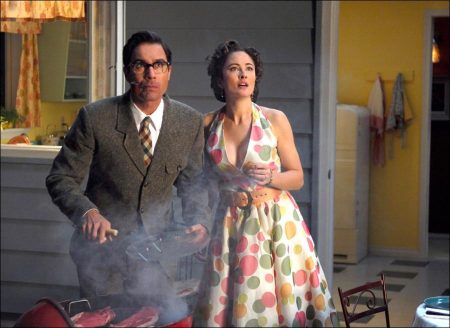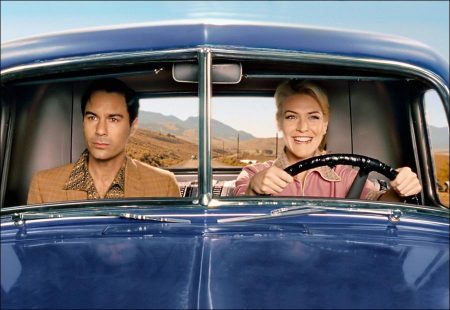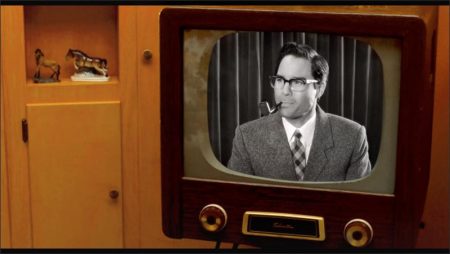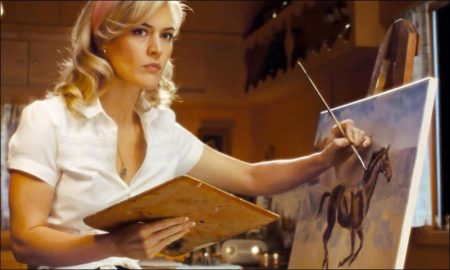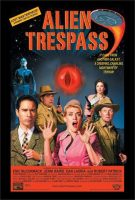That Mid-Century Look
The `50s retro ambience in Alien Trespass is an essential component of the filmmakers’ vision and Goodwin assembled a crew he was confident could overcome any time or financial limitations. He had previously worked with David Moxness, CSC (aka Moxy), the Canadian cinematographer who had recently won the American Society of Cinematographers Award for his work on the popular TV series “Smallville.” “And if a Canadian wins that (American) award, you know he’s got to be pretty good,” notes Goodwin.
Ian Thomas came aboard as production designer, “because he has wonderful taste and I knew that he and his set design crew would be able to get a lot up there on screen,” says Goodwin.
The task of creating and assembling the film’s costumes fell to Jenni Gullett, with whom Goodwin had collaborated frequently since they first worked together on “The XFiles.” Editing chores went to veteran cutter Michael Jablow, A.C.E. and his longtime collaborator Vaune Kirby. “Michael is responsible for editing some of the funniest comedy films ever, including `Throw Momma from the Train’ and such recent films as `The Game Plan’ (starring Dwayne “The Rock” Johnson),” Goodwin mentions.
ALIEN TRESPASS was shot mostly in and around Vancouver and the interior of British Columbia “because, as I learned on `X-Files’ you can make it look like almost any place,” says Goodwin. “It even has a desert (which came in handy for the exteriors that take place in California’s Mojave Desert where the alien spaceship lands).”
As with all his projects, Goodwin compiled copious materials to illustrate his vision to his cast and crew. “We clipped photos from `50s-era magazines and showed them photos of home interiors, costumes and hairstyles from the period,” he says, “so that everybody had a clear image in their mind of what we wanted to achieve.”
ALIEN TRESPASS is technically Goodwin’s first feature film directorial project, but the time and money constraints it presented were nothing new to him. After years in television, he did not feel in the least bit daunted with shooting a feature-length film in a very few weeks.
“Many years of directing TV shows has been a real crucible for me,” he explains. “With `X-Files,’ every episode was like a little movie shot in the cinematic style we insisted on for the show, and that’s what I drew on for ALIEN TRESPASS. Even though it was a short schedule, to me it was way more time than I had on `X-Files’ and I had great people supporting me, which is the only way you can stay on top of it all and get it done.”
Still, the attenuated production schedule for ALIEN TRESPASS involved many challenges, according to producer Swift. “I never imagined how incredibly complex, creative and labor intensive making a movie really is. Somehow, thanks to the top-flight crew, various problems were resolved, from figuring out how to craft a unique `50s movie monster that moved in a unique way, to building a realistic flying saucer.”
Mother Nature and human nature, also presented obstacles, says Swift. “There were numerous location and night shoots in which rain was always threatening. And there was the constant challenge of staying true to the story’s authentic `50s look. We even had a disgruntled business owner who tried to sabotage production but, fortunately, was caught at it red-handed by a smart local police officer.”
For fledgling screenwriter and movie novice Fisher, the experience of being on a movie set for the first time was a real eye-opener. “After being on the set for several days and witnessing the multitude of the cast and crew and the seeming chaos all around me because of the zillions of things that need to happen – or can go wrong – I was astonished that any movie gets made at all,” he remarks.
The production was also a great learning experience for Swift. Despite his lack of previous producing experience, Goodwin included him in every step of the process from pre-production, principal shooting through to post-production. “Jim and I were pretty much of a mind on what we wanted on this film,” Goodwin mentions. “We were on the same path on how it should be shot, edited and what the music should sound like. He may have had no previous TV or filmmaking experience, but his instincts were great.”
“It was an amazing experience and I’m so grateful to Bob and the cast and crew, without whom my original story idea would have stayed forever just an idea,” says Swift. The deep, saturated color in ALIEN TRESPASS is modeled after one of Goodwin’s favorite sci-fi movies, the original “War of the Worlds,” which he calls “sumptuously beautiful.” Early on, he and his cinematographer, Moxness, came to a decision about how to achieve that “glorious Technicolor” look that Goodwin wanted and in the most cost and time effective manner.
“One early thought was to shoot high definition video,” explains Moxness. “I thought that would be wrong for the project. Our intent going in was that this was meant to be a sci-fi film from 1957 and, for that, shooting in HD would be the wrong aesthetic. It would leave the film without an inherent `texture.’ The goal was to stay true to the conventions of a `50s sci-fi the best we could. Shooting on film was very important in achieving this. Since 35 mm. would have been cost prohibitive, we settled on Super-16. We were lucky to obtain Arriflex 416 cameras, which were very versatile and allowed us to shoot easily and effectively.”
“In our attempt to stay true to the convention of a `50s sci-fi movie, I tried to shoot the film with just three lenses,” adds Moxness. “I think it’s not necessarily something audiences will pick up on, but they will feel a sense of odd consistency; something will seem right, even though they can’t quite put their finger on it.”
One of the major attractions of ALIEN TRESPASS for production designer Ian Thomas was the time frame in which the story transpires. “Every production designer loves to do period films and I especially love the 1950s – the furniture, the cars and the music – so naturally, I really wanted to do this film,” Thomas confesses.
Another lure was director Goodwin. “Bob loves his work and he loves this period, I guess because he grew up in California during that era. He was a pleasure to work with, very respectful of me and my designs. He always gave me a lot of room to do my work and was always excited to see the sets come alive.”
Thomas relied on his gut instincts as a production designer for the look of the film, rather than any specific `50s sci-fi movie. He coordinated his designs with cinematographer Moxness and costume designer Gullett. “The big thing for me is always the color of my sets, so it can be very embarrassing if that’s not coordinated with the camera and costume departments.”
Doing a `50s period film enabled Thomas’ set design crew to take full advantage of what Vancouver, Canada has to offer. “Vancouver is a great city for `50s furniture, so most of our set decorating came from local stores. Some things, like the fabric for the window dressing, were a little harder to find, but we came up with good alternatives by using newer patterns.”
The vivid set colors were from Benjamin Moore, says Thomas. “They have some great `heritage’ colors. David Moxness and I spend a lot of time going over my choices before we actually put paint on the sets.”
One of the production designer’s more formidable tasks was transforming Ashcroft, a small burg four hours north of Vancouver, into a credible Mojave Desert town. “This little sleepy town looks a lot like the desert,” says Thomas. “We shot only the wide shots there and all of our close-ups in a local gravel pit or on a soundstage.”
Other locations included neighborhoods near Vancouver with “quaint houses built in the 1950s, an operating movie theater and a genuine `50s diner that had to be completely reworked and reassembled,” says producer Swift. “It’s not so easy traveling back in time 50 years without the use of CG, which we avoided.”
The vintage autos in the film were all found locally. “There are many car buffs out here on the West Coast and they keep the cars in great shape. Not much had to be done to make them look authentic,” says Thomas.
Adds Goodwin, “The cars were so immaculate and perfect we had to dirty them up a bit to look like people drove them every day.”
As with all non-studio movies, Thomas’ main obstacles were a tight budget and a short schedule. “The biggest challenge was building so many interior and exterior sets with the small amount of money we had. Another was that we had only two small stages on which to erect our sets, so we had to be very creative with putting in and taking sets away as we shot them, and then assembling more at night or on the weekend to be ready for the shooting crew.”
His proudest achievement, he says, was one particular set: “The main house (where Ted Lewis and his wife, Lana, live) with the backyard attached to the kitchen, which was built on a very small stage. That was the most fun to design and decorate.” Producer Swift also singles out that particular achievement. “Check out the kitchen; it’s perfect `50s in every detail, enhanced by the camera set-ups and lighting.” Thompson also says the kitchen set was her favorite. “Every square inch of that space was considered. Even the fridge was stocked with fresh eggs in a Pyrex bowl and there were glass bottles of cream and milk,” she notes.
“That kitchen set is to die for,” adds Goodwin. “But everything Ian did was perfection. I defy you to find anything in the movie that isn’t genuine 1950s.” McCormack was aware of how special the finished film was going to look just from watching dailies. “It was amazing how `50s the movie looked in a grand Technicolor sort of way. The colors pop like crazy, which is a miracle when you consider how little time we had to shoot it.”
Goodwin and Moxness realized that the color-saturated look of the film was not strictly true to the genre’s B-origins and knew they were walking a fine line between paying homage and making a film that had a contemporary sensibility. “We worked very hard to stay true to the style of `50s B movie sci-fi,” says Moxness. “However, something had to give because I was working with modern film stocks and lenses. In the end, we decided that to present this story to today’s audiences, there had to be some crossover. So I set out to create our very own type of `Technicolor’ look that would complement the actors’ onscreen work and result in something that was akin to the era, but also made it our own.”
For costume designer Gullett, creating the look she wanted required three key elements, research, research and research. She studied 1950s period movies, costume history, books, catalogues and periodicals, as well as online photo references. Her color palette for the movie was of a piece with Thomas’ production design and Moxness’s visual scheme, she says. “The colors were obviously `50s inspired and warm, including certain shades of green, pink, rust, mustard and other earth tones, as well as some lighter blues,” says Gullett.
Many of the outfits were rented from costume houses, some of it was vintage, but there were also some retro creations, and Gullett was pleased to find much of it in very good condition. Most of the clothing for McCormack and Baird was designed and constructed to conform to period guidelines and silhouettes. “It was easy to find present- day fabrics that we cheated for 1957,” she says. “Women’s foundation garments were paramount in creating the feminine shape of the period. We found an online store that sold all the items we needed, including seamed stockings and bullet bras. Many of the accessories were rented, but as we became more familiar with the era, we found some contemporary pieces that followed the same design sensibility and principals.”
Gullett collaborated with Goodwin in devising the spaceman Urp’s iconic silver suit. “Bob had definite ideas and guidelines he wanted to incorporate and I had some suggestions as well. After presenting him with a few sketches, we finally decided on one and, once we had an actor, we started building. There were some alterations and modifications but the final design is what you see in the film.”
Goodwin approached Louis Febre, a student of `50s sci-fi movies, to do the score, says Swift. “Louis created an authentic, exciting score with full orchestral sound, and we used the renowned theremin player Rob Schwimmer to provide the eerie musical effects.”
“The reason I chose Louis is that, in addition to being a brilliant film and TV composer, he is actually a student of `50s sci-fi scores,” says Goodwin. They had first worked together on the CBS production “The Fugitive,” on which Goodwin was executive producer and Febre composer. “He has spent a great deal of time studying those films and is one of the top experts in the world. He even wrote a treatise about it, and his expertise on composers like Bernard Herrmann and Max Steiner and their lush orchestral sound made him ideal not just for the scary parts of the score, but for the beautiful romantic theme he created for the scene of Ted and Lana’s anniversary.”
In his selection of Schwimmer, Goodwin again went for the very best, a thereminist who had played with the New York Philharmonic and with such popular musicians as Paul Simon and Stevie Wonder. “Rob created some genuinely creepy moments,” he says.
Like Febre, Schwimmer was no stranger to the `50s sci-fi genre and its innovative use of the theremin. Observes Schwimmer: “The almost omnipresent theremin and that particular playing style in sci-fi movies of the `50s (most notably `The Day the Earth Stood Still’ and `It Came from Outer Space’) gave a flavor that, when heard now, instantly transports you back into that era. It was the same thereminist who played on all Hollywood movies, Dr. Samuel J. Hoffman. He had a fast vibrato (which was the way he always played, and not just for sci-fi) which became `the’ sci-fi theremin sound that we all know and love. In ALIEN TRESPASS, it seemed a fitting tip of the hat that not only the theremin be included as an homage to its Hollywood sci-fi heritage, but to Dr. Hoffman’s playing style as well.”
Scary Family Fun
One of her co-stars, Jody Thompson, believes the movie will appeal to a variety of audiences. “Die-hard sci-fi fans and B-movie aficionados will have lots to talk about in terms of the historical accuracy and the production aspects of the film, and anyone who appreciates a sweet story with lots of heart should enjoy this blast from the past.”
Observes co-star Dan Lauria, “Anyone who’s ever seen an old `50s horror movie will respond to the silliness of ALIEN TRESPASS. It’s funny because we played it straight. And the credit for that goes to Bob Goodwin.”
Robert Patrick believes ALIEN TRESPASS could be a terrific antidote to the seriousness of our times. “I would hope that kids get on board with it, as well as fans of sci-fi movies from the `50s. The timing is perfect for this movie, given that the state of affairs of the country and the world is so terrifying that it’s nice to have something warm and fuzzy like this film in our lives, something that harkens back to a simpler time, gives us a nostalgic feeling and makes us feel good.”
“I’ve screened this movie around the country and even in Sydney, Australia and found that it appeals to all ages,” says Goodwin, “from people who love the original movies, to nostalgia freaks, to 18-year olds who’ve never seen them. The main thing everyone responds to is the fact that the movie represents a simpler time and a kind of optimism. It’s a feel-good movie.”
There is one good reason why the film was able to achieve that delicate balance between past and present and do it so seamlessly, says Swift. “ALIEN TRESPASS owes its success in achieving those goals to Bob Goodwin, who meticulously planned and executed the film and hired great people to help him realize his vision. That, and a pinch of luck.”
Another balance Goodwin achieved, says McCormack, “is the balance between scary and fun scary. ALIEN TRESPASS is terror the whole family can enjoy.”
Alien Trespass (2009)
Directed by: R.W. Goodwin
Starring: Eric McCormack, Jenni Baird, Dan Lauria, Robert Patrick, Jody Thompson, Aaron Brooks, Sarah Smyth, Andrew Dunbar, Sage Brocklebank, Tom McBeath, Laura Carswell, Tom McBeath
Screenplay by: James Swift
Production Design by: Ian D. Thomas
Cinematography by: David Moxness
Film Editing by; Vaune Kirby Frechette, Michael Jablow
Costume Design by: Jenni Gullett
Set Decoration by: Louise Roper
Art Direction by: Douglasann Menchions
Music by: Louis Febre
MPAA Rating: PG for sci-fi action and brief historical smoking.
Distributed by: Roadside Attractions
Release Date: April 3, 2009
Views: 405
